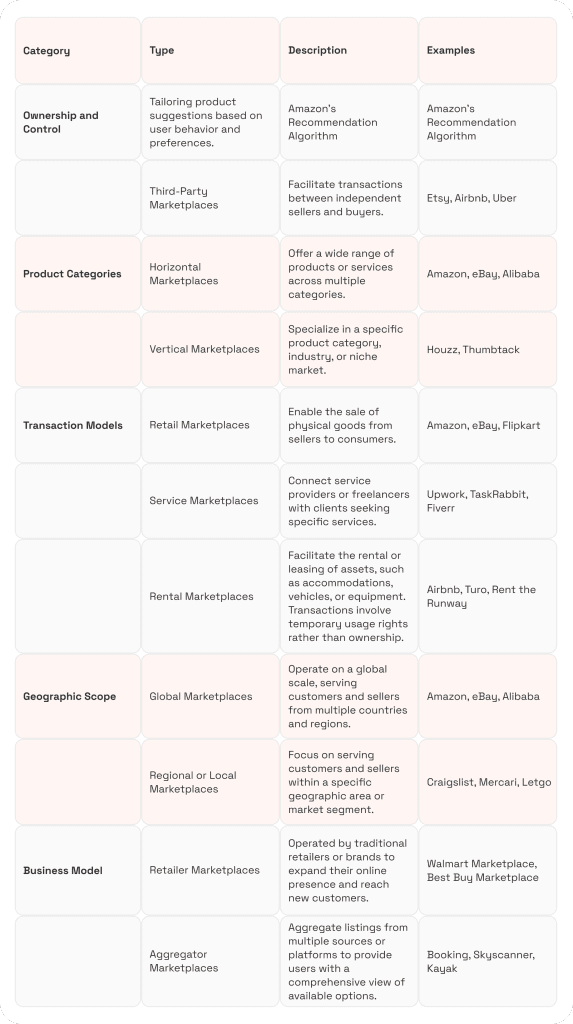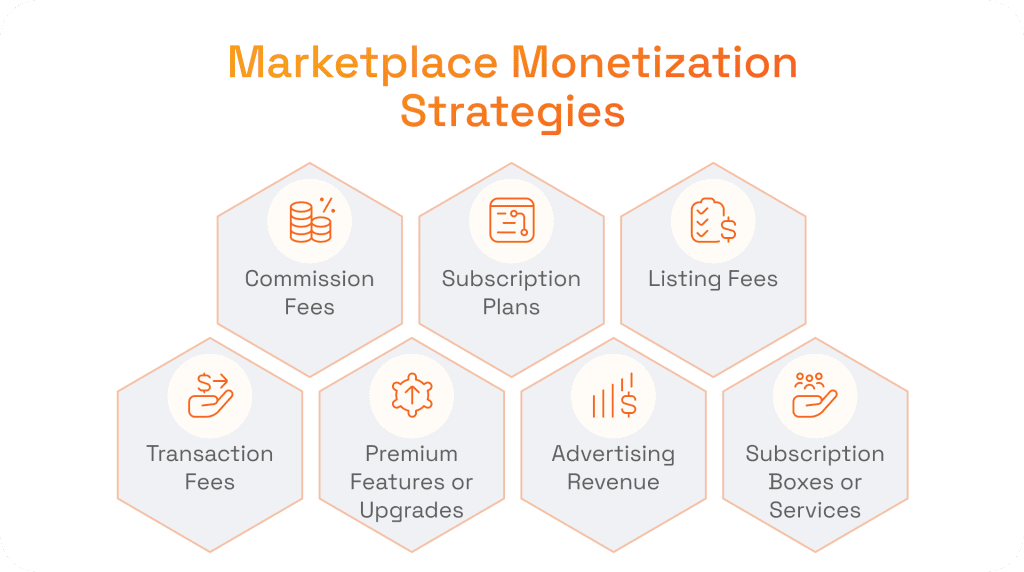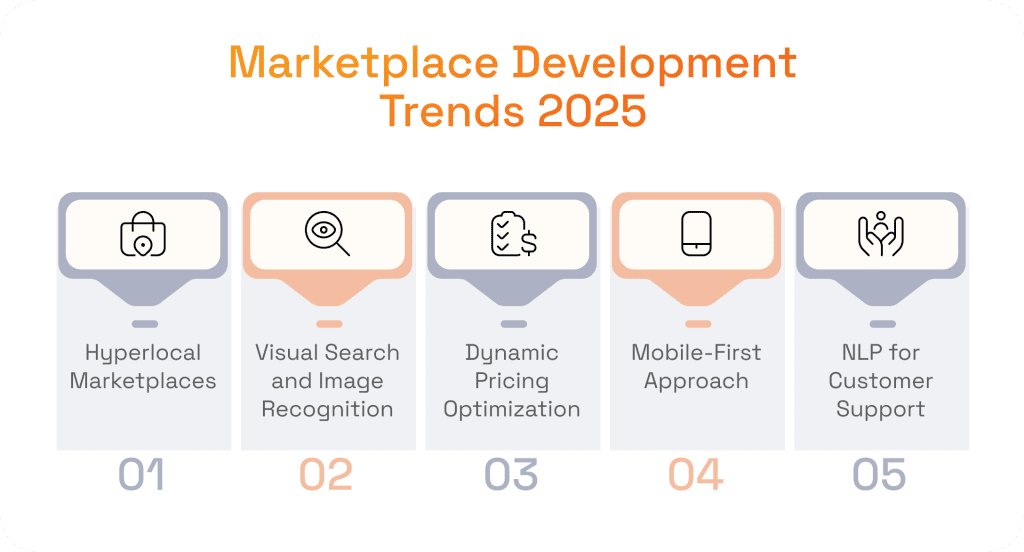In 2025, 21% of all retail purchases are expected to occur online, and this share is projected to rise to 22.6% by 2027, according to Sellers Commerce. The same source reports that there are currently 28 million eCommerce stores globally. So, while opportunities seem endless, to capitalize on them, you need the help of a trusted and proficient development partner capable of creating a competitive platform with the potential to capture leading market positions.
Being one of our fortes and having decades of experience in creating online marketplaces, we are happy to share our insight, marketplace development expertise, and practice-proven insights.
While there are many marketplace development platforms, and no-code marketplace builders that can work for small-sized businesses, we believe that custom development is the most strategic approach for forward-thinking eCommerce companies. So, let’s discover how to make a marketplace website that will possess the technical and marketing capabilities to propel your business to new heights.
Step 1 – Setting Up a Marketplace as a Business
The journey of establishing a marketplace as a business begins by making key decisions about the type of online marketplace you want to create. Making this decision will determine how your marketplace business operates, how it generates revenue, and how it interacts with both sellers and buyers.

1.1. Choose the marketplace type
Selecting an online marketplace type should be closely aligned with your core business strategy. If you struggle to make the right decisions during the planning stage of marketplace development, start by analyzing existing opportunities, reviewing possible types of marketplaces, and identifying a winning gap in the market.
Oleksandr Boyko
Delivery Director at SPD Technology
“It is very important to have a distinct understanding of what actual problem you solve when you build your own marketplace. Similar to how Uber focuses on making ride-sharing simple, your idea must have a clear value for the client. When you have this vision, analyze the competition in your niche to evaluate your chances before going any further.”
Based on Ownership and Control:
- Owned marketplaces are platforms that are fully owned and operated by a single entity or company that has complete control over all aspects of the platform, including product offerings, pricing, customer service, and policies. The most prominent examples of this include Amazon and Walmart Marketplace.
- Third-party marketplaces only facilitate transactions between independent sellers and buyers. The platform operator acts as an intermediary that connects buyers with a variety of sellers. The platform typically charges fees or commissions to the sellers for listing their products and completing transactions, with the most popular examples being Etsy, Airbnb, and Uber.
If you want to have a high level of control over customer experience and branding when you are selling products, an owned marketplace can be a suitable business model. However, if you want to minimize your own inventory risk and just connect buyers and sellers, a third-party marketplace can be an option for you.
Based on Product Categories:
- Horizontal marketplaces offer a wide range of products or services across multiple categories. These types of online marketplaces are aimed at a broad audience, serving diverse needs by providing an extensive selection of goods and services. The primary goal here is to be a one-stop shop for customers, allowing them to find almost anything they need on a single marketplace platform. With this type, it is hard to develop precise marketing strategies, since the customers are very different, and there is pressure from the competitors in this niche, including global leaders like Amazon and eBay.
- Vertical marketplaces, on the opposite, are very narrow and aimed at a specific niche, industry, or demographic. It is possible to save money on marketing efforts, as marketing strategies can be more tailored and allow for gaining more revenue from a smaller number of customers. However, the selection of the right niche is essential here to be a success like Houzz, Thumbtack, and StockX.
Based on Transaction Models:
- Retail Marketplaces enable the sale of physical goods from sellers to consumers, typically for personal use or resale. Among the prime examples are Amazon, eBay, and Flipkart.
- Service Marketplaces are connecting service providers or freelancers with customers in need of specific services. It can be consulting, design, professional help, gig work, repairs, or digital tasks. Upwork, TaskRabbit, and Fiverr are currently holding the leading positions in this niche.
- Rental Marketplaces are for the rental or leasing of assets, including accommodations, vehicles, or equipment. Unlike retail online marketplaces where ownership is transferred, rental marketplaces involve temporary usage rights, allowing users to rent items for a specified period, with prime examples Turo, Rent the Runway, or peer-to-peer marketplace website Airbnb.
Based on Geographic Scope:
- Global Marketplaces operate on an international scale, connecting buyers and sellers from multiple countries and regions around the world, while offering a vast selection of products or services, catering to a diverse global target audience. They are specifically tailored to handle complex logistics, cross-border regulations, and multilingual support, enabling transactions across different cultures and time zones, just like Alibaba or Amazon.
- Regional and Local Marketplaces focus on serving customers and sellers within a specific geographic area, for example, a country or city. These online marketplace websites are designed to meet the unique needs and preferences of local target markets, with examples including Craiglist and Mercari.
Based on the Business Model:
- Retailer Marketplaces are operated by established retailers or brands like Walmart or Best Buy with the goal of online presence and offering a broader range of products, reaching out to more potential customers from a target audience. These platforms allow marketplace owners to sell items directly from their inventory, while also inviting third-party sellers to list their products.
- Aggregator Marketplaces, on the other hand, just collect listings from different sources, to simplify the search and comparison process for the target audience by providing a holistic view of suitable product options. Aggregator marketplaces are particularly popular in industries where comparison shopping is essential, such as travel, real estate, and online services.
1.2. Depending on the type, choose the monetization strategy
It’s time to select the most suitable business model that will help your marketplace idea to become a profitable platform.

Below are the most common monetization strategies:
Commission Fees
This is a popular pricing model for third-party marketplace platforms, where the sellers are charged a percentage of the transaction value for each successful sale. It also helps keep upfront costs low for sellers, making it easier for them to join and scale their business on the platform. This marketplace business model makes it mutually beneficial for both parties, as the platform’s revenue is aligned with the success of each seller.
Subscription Plans
This marketplace business model is particularly suitable for service and niche marketplace platforms, where sellers or service providers pay a recurring fee to access the platform’s premium features or services.
Listing Fees
With this marketplace business model, the sellers are being charged a fixed sum for each product or service they list, regardless of the fact of sale. It is quite common among retailers and niche online marketplaces, where it is important to invest in maintenance and moderation.
Transaction Fees
This involves charging a flat fee or a percentage of the transaction value to buyers, sellers, or both for each completed transaction. The fee structure may differ, for example, a flat rate per transaction or a certain percentage, based on the value of the transaction.
Premium Features or Upgrades
This is one of the more flexible marketplace business models, that allow owners to get additional revenue by offering enhanced capabilities to sellers or buyers, especially popular in service marketplaces. The features that can turn into a competitive edge may include advanced analytics, promotional tools, or priority customer support.
Advertising Revenue
This is a vital strategy for horizontal and aggregator marketplaces, where the platform is visited by a massive and diverse audience. The owners can sell advertising space to third-party advertisers who are interested in reaching their user base and benefiting from this value proposition.
Subscription Boxes or Services
It is a unique marketplace business model for subscription-based and retailer marketplaces. The online marketplace website curates products from multiple sellers or brands and offers them to consumers as part of a subscription service. Subscribers pay a recurring fee to receive a selection of products regularly.
Step 2 – Creating a Marketplace Technical Infrastructure
With planning and business aspects of the marketplace website launch out of the way, we should move on to the nitty-gritty of the marketplace development.
Oleksandr Boyko
Delivery Director at SPD Technology
“To build marketplace platform, you need to gather the requirements, complete market research, create specification documents, design wireframes, estimate the delivery time, and settle on a budget. Depending on the budget and scale of the project, it may require a wide variety of specialists such as Back-end and Front-end engineers, Quality Assurance/Automation engineers, and UI/UX designers. Depending upon how the marketplace development process will be managed, you may need Project Managers, Product Managers, and Business Analysis Specialists. We have all this talent at SPD Technology, and thanks to our powerful recruiting department, can find more rare experts when required.”
2.1. Infrastructure and Hosting
The choice of infrastructure and hosting is foundational to the online marketplace website’s performance, security, and scalability.
Selecting Cloud Infrastructure Provider
The top contenders worth mentioning here include Amazon Web Services, Microsoft Azure, and Google Cloud Platform. All three provide robust infrastructure solutions that cater to the most demanding online marketplace business needs.
- AWS is known for its vast array of services, global reach, and proven track record in scalability and reliability.
- Microsoft Azure has seamless integration with Microsoft products, offering excellent support for hybrid cloud environments.
- Google Cloud Platform has data analytics, Machine Learning capabilities, and competitive pricing, making it stand in Big Data processing and advanced AI integrations.
Network Configuration and Security
A well-designed network setup is crucial for the marketplace’s efficient operation, ensuring data security in Fintech, eCommerce, or any other industry connected to sharing sensitive personal data and financial transactions.
This process starts with the creation of a Virtual Private Cloud (VPC), which isolates the marketplace’s environment within the broader cloud infrastructure. Security groups and firewall rules are then established to control traffic flow to and from the online marketplace. To safeguard sensitive data, encryption protocols are implemented, and, additionally, access controls including Multi-Factor Authentication (MFA), Role-Based Access Control (RBAC), and monitoring access logs for suspicious activities are essential.
2.2. Back-end Development
The core of web development services, back-end coding, will bring the business ideas to life and turn them into actionable business features.
Implementing Business Logic
At the heart of any marketplace development project is a set of core functionalities that drive its operations. These include user authentication, product catalog management, order processing, and support of e-payment systems for eCommerce. Each of these elements requires meticulous planning and precise implementation to ensure everything runs smoothly and securely.
Oleksandr Boyko
Delivery Director at SPD Technology
“The choice of programming languages and frameworks for starting an online marketplace is strongly influenced by performance, scalability, maintainability, and your specific needs. Popular programming language choices include Java, JavaScript, Ruby, Python, and PHP, with each having its advantages. Having 18+ years of experience in eCommerce marketplace development here at SPD Technology, I can say that Java is a great choice for dealing with the most sophisticated marketplace websites. We also have a ton of experience with Python, after delivering AI/ML software for our clients.”
Integrating with External Services
When learning how to build an online marketplace, you’ll find out that numerous integrations with external vendors must be established. You may need features like geolocation services, social media analytics, shipping logistics, or payment processing. You will also need an expert team to implement them properly, plus introduce error handling, retry mechanisms, and fallback strategies to prevent any disruptions.
Speaking of payment processing, we have an entire article on how to build a payment gateway, in case you need something much more versatile and powerful to facilitate transactions compared to off-the-shelf solutions.
2.3. Front-end Development
While the back-end is responsible for accurate functionality, the front-end is all about seamless and engaging user experience for the target audience, tailored to your marketing goals.
UI/UX Design
It will be a good idea to begin with user journey mapping, which involves charting various paths potential customers might take while interacting with your online marketplace to identify critical touchpoints and potential friction areas.
After that, the design process starts with creating wireframes, and simple sketches that outline the structure of your marketplace idea, visualizing the layout, information hierarchy, and placement of key elements. Once the wireframes are approved, designers move on to creating mockups, more detailed visualizations, and then prototypes to enable interaction testing before the actual development process.
Developing Responsive Web UI
When you get an understanding of how to create a marketplace and take the proper steps in this process, it is essential to develop a user interface that adjusts seamlessly across various screen sizes and devices. This development process requires writing efficient HTML, CSS, and JavaScript code, and leveraging modern front-end frameworks like React, Vue.js, or Angular to enhance development efficiency and maintainability.
We have a great example of UI/UX design in our project for a plumbing online marketplace when we conducted a comprehensive audit and redesigned the interface according to the latest design principles and usability standards.
Brand Identity Integration
Whether you operate business-to-business or business-to-consumer, make sure to establish a recognizable and consistent experience for users, letting them know what your brand is all about in each interaction.
Ensuring mobile responsiveness
During the development process, consider touch-based interactions and gestures for mobile devices, as well as touch-friendly elements and controls, such as larger buttons and swipeable carousels, to accommodate mobile usage patterns.
Integrating with Backend APIs
Integrating front-end components with backend APIs is critical in ensuring that the user interface is both dynamic and responsive. This integration allows the front-end to communicate with the back-end services, fetching and displaying real-time data, processing user actions, and updating the UI seamlessly. Your development team should also implement client-side data caching and performance optimization activities including compressing images, minifying code, and optimizing server responses.
Step 3 – Ensuring Seamless Marketplace Operations
Now, let’s discuss how to start an online marketplace with effective communication channels to facilitate smooth interactions between potential customers and sellers.
3.1. Messaging and Communication
When you build an online marketplace, timely communication is critical, to ensure that all customer interactions will turn into revenue.
Real-Time Chat Functionality
Utilizing technologies like WebSockets or Firebase can help in achieving low-latency, real-time communication for your platform. Enhancing this system with typing indicators, read receipts, and instant notifications for new messages, can significantly improve the user experience as well.
Inbox Management
Designing an intuitive inbox interface and implementing features for organizing messages, filtering conversations, and archiving or deleting messages when needed, will further improve the convenience for the end-users.
Notification System
Implementing a robust and customizable notification system while building a marketplace is a must. Make sure to provide functionality that allows your customers to adjust their notification preferences as they require.
3.2. Transaction and Payment Processing
When you build a marketplace, providing smooth, secure, and efficient payment operations is a key functionality that must be executed on the highest level.
Payment Gateway Integration
To enable seamless and secure transactions, your development team should integrate a reliable payment gateway using well-documented APIs or SDKs. This involves configuring backend systems to handle payment requests, responses, and callbacks while ensuring compliance with PCI DSS standards and minimizing friction in the user checkout experience. Our company provides end-to-end payment gateway integration services, so we know the importance and how to properly integrate with top vendors including Stripe, PayPal, or Square, while implementing features for handling various payment methods including сredit and debit cards, gigital wallets, bank transfers, and multiple currencies.
Want to know how to integrate a payment gateway into your app?
Read our article to get more details and find out how to do it right!
Transaction Security
To ensure payment gateway security, your development team should implement encryption, tokenization, and other security measures to protect sensitive payment information. Here, at SPD Technology, we believe that if you want to create your own online marketplace, you should heavily consider building custom AI-powered fraud detection and risk management systems to minimize the possible risks even further.
Escrow Services
It is a common practice to provide escrow services in your marketplace business as well, to hold funds securely until transactions are completed satisfactorily, reducing the risk of disputes and ensuring trust between buyers and sellers.
3.3. Order Management and Fulfillment
Next, we should discuss the key elements of order management, to ensure that your chosen business models will perform at their best.
Order Processing Workflow
Upon order placement, an order confirmation is generated and sent to both the buyer and the seller, detailing the order specifics. Modern marketplace platforms should have built-in features that automatically update inventory as orders are placed, canceled, or returned. The functionality should include generating shipping labels or packing slips, depending on the fulfillment model. The system should also provide order tracking capabilities, allowing both sellers and buyers to monitor the progress of the order from confirmation to delivery.
Inventory Management
The marketplace business should provide robust tools for managing product inventory, enabling sellers to track stock levels in real-time. The online marketplace should also support the management of product variations. Integrating the platform with external inventory management systems or third-party logistics providers can further streamline the fulfillment process.
Shipping and Logistics Integration
Integrating the online marketplace platform with shipping carriers and logistics services allows sellers to offer accurate shipping rates, delivery options, and tracking information to buyers at checkout, while the platform should generate shipping labels and packing slips automatically. Nowadays, buyers on marketplace websites expect to receive tracking information almost instantly and are used to features like multi-carrier support, real-time carrier rate comparisons, and automated shipping rules.
Oleksandr Boyko
Delivery Director at SPD Technology
“As you see, the development process is a complex and time-consuming endeavor that can take a significant chunk of your budget. So, it will be a good idea to build a Minimum Viable Product (MVP) first, to check how users interact with your online marketplace and what improvements are required.”
Step 4 – Ensuring Data Privacy Compliance and Security
Given the sensitive nature of the data handled when you build a marketplace platform, adherence to the stringent privacy regulations is of utmost importance.
4.1. Privacy Compliance
Online marketplaces must align with global and regional data privacy regulations, such as the General Data Protection Regulation (GDPR) in Europe and the California Consumer Privacy Act (CCPA) in the United States. You can comply with them by implementing privacy policies, consent management features, and data protection measures. It is also important to have advanced data encryption, anonymization, and access control mechanisms.
4.2. Transaction Processing Compliance
Marketplace websites are obliged to the Payment Card Industry Data Security Standard (PCI DSS), a set of security standards designed to protect cardholder data and ensure secure payment processing. Compliance with PCI DSS involves encryption of payment data, the implementation of strong access control measures, and regular security testing.
Read our article on PCI DSS compliance checklist to get a complete understanding of how to start an online marketplace with the highest level of security in every transaction.
4.3. Security Monitoring and Incident Response
It is common for online marketplaces to deploy a combination of security monitoring tools, such as intrusion detection systems (IDS), firewalls, and vulnerability scanners. Regular security audits and penetration testing are also crucial for identifying and addressing security weaknesses. However, even with the best security practices, incidents may occur, and you should work with your development team on a robust incident response plan.
Step 5 – Launch, Marketing and Growth
Finally, after your long journey to create your own marketplace website, the day has come to make it successful and attract customers.
5.1. Launch
Before launching, you should build anticipation by teasing your brand-new online marketplace on social media, arranging promotions in blogs, mentions by influencers, and publishing your press releases in email newsletters. Another common tactic is to offer exclusive early access or beta testing to a select group of users to generate additional excitement and collect valuable feedback.
5.2. Marketing
Use as many chances as you can to improve the connection with your customers, covering the essential areas after creating a marketplace website:
- Content Marketing: work on meaningful and highly engaging content, and post it in various formats including blog posts, tutorials, or videos on YouTube.
- Social Media Marketing: always learn something new about emerging social media trends, to maximize your efforts with current platforms.
- Email Marketing: a great way to engage your customer is to send targeted campaigns with important updates and offers regarding your online marketplace.
5.3. Growth
To grow, you should constantly collect feedback from users and stakeholders. While sometimes it will not be as positive as you want, you will be able to leverage it to find ways to improve your online marketplace. You can always adjust your marketing strategies, brand messaging, and the elements of user experience for the better.
5 Marketplace Development Trends to Capitalize on in 2025
The eCommerce market is booming, as Statista reports that by the end of 2025, e-commerce sales are estimated to exceed $4.3 trillion worldwide, so it is the right time to capitalize on the current online marketplace development trends. We picked the most interesting ones and provided our insights on implementing them most effectively.

1. Hyperlocal Marketplaces
These marketplaces focus on catering to the specific needs of users within a defined geographic area, often emphasizing convenience, quick delivery, and community engagement. The potential of this trend is quite impressive, as according to Custom Market Insights, the global hyperlocal market is expected to be valued at $6.4 trillion by 2032.
Trend implementation strategy:
- Understand Local Needs: conducting detailed market research will help identify the unique needs, preferences, and pain points of the target audience. This includes analyzing local consumer behavior, identifying gaps in existing services, and pinpointing opportunities where your marketplace can add significant value.
- Partner with Local Businesses: by partnering up with local vendors and service providers, you can ensure that you attract buyers by offering a wide range of products and services. You can offer local businesses lower rates or advertisement support to encourage the most lucrative partnerships.
- Geolocation Integration: by maximizing the potential of geolocation features, both sellers and buyers will be able to easily discover offerings in the local area. This not only enhances user convenience but also strengthens the connection between the marketplace and the local community.
- Facilitate Community Interaction: leveraging the online marketplace features like local reviews and community forums, as well as encouraging user-generated content, will not only help users to engage but also establish your platform as a central hub of the local community.
2. Visual Search and Image Recognition
The global image recognition market is anticipated to reach around USD 184.55 billion by 2034, poised to grow at a CAGR of 13.26% from 2025 to 2034, if Precedence Research is to be believed.
This is a great example of Artificial Intelligence in retail, as the online marketplace involves an enormous potential for the implementation of computer vision and machine learning.
Trend implementation strategy:
- Build Image Database: curating a collection of product images from sellers and other sources for your online store is a great way to start with computer vision development.
- Implement Image Recognition Algorithms: having consistently high-quality images is essential for accurate work of ML algorithms and computer vision technology. By extracting relevant product attributes and features, the technology can match user-uploaded images with visually similar products in the catalog.
- Visual Search Functionality: implementing visual search, software developers are allowing users to search for products using images instead of text queries, elevating user experience to another level.
- Continuous Improvement: continuous training and improvement is essential here, as with any other type of ML algorithm. Image recognition models can be improved based on user feedback, data insights, and algorithm performance metrics.
Looking for a trusted partner that knows how to build a marketplace website? We prepared a list of the best eCommerce development companies to help you find a perfect custom marketplace development vendor.
3. Dynamic Pricing Optimization
In 2025, it can be considered a very common functionality for leading marketplace platforms, as dynamic pricing is widely considered a powerful tool that adjusts optimal prices in real time based on demand, supply, competition, and customer behavior.
Trend implementation strategy:
- Data Analysis and Modeling: analyzing historical data is the first step you should make, as sales data, market trends, and competitor pricing can provide you with a basic understanding of the current pricing situation of your online platform. Based on this data, with machine learning techniques, it is possible to develop predictive models for optimal real-time price forecasting.
- Define Pricing Strategies: in defining pricing strategies for a successful marketplace, it is crucial to consider demand fluctuations, inventory levels, and competitor actions. You should also consider the seasonality, customer segmentation, and promotional campaigns to ensure that the strategy aligns with your business goals.
- Real-time Pricing Updates: implementing automated mechanisms that adjust prices in response to market conditions ensures that your marketplace business remains competitive while maximizing revenue. This automation not only improves the efficiency of selected pricing strategies but also saves time on price changes across different product categories and segments in your online marketplace.
- A/B Testing and Experimentation: by testing different pricing configurations, discount levels, and promotional offers, you can detect the most effective approaches for your online platform. Monitoring sales volume, revenue, and profitability during these experiments will help identify the best strategies or fine-tune the ones you are already using.
- Monitor Performance and KPIs: leveraging data analytics and reporting tools can help to track outcomes and provide insights into how well the pricing strategies are working, allowing for ongoing adjustments and improvements. First and foremost, pay attention to KPIs including revenue per visitor, conversion rates, and margin optimization.
4. Mobile-First Approach
As mobile devices continue to conquer the world, only in the United States of America, the smartphone adoption rate is expected to hit 89 percent by 2030, according to Statista. So, it’s safe to say that when you are building an online marketplace, adopting a mobile-first approach is a necessity, and no longer just an option.
Trend implementation strategy:
- Responsive Design: having responsive design in place will ensure that your marketplace platform is optimized for all screen sizes and resolutions. To achieve this goal, your software developers should use several techniques including flexible layouts, fluid grids, and media queries.
- Mobile App Development: developing a native or cross-platform marketplace mobile app will add another layer of mobile integration for your business, providing a seamless and intuitive user experience. With a reliable software development partner, it is possible to leverage platform-specific features such as push notifications, offline access, and faster load times to significantly enhance user retention.
- Touch-Friendly Interactions: optimizing the user interface for touch-based input, that is relevant for mobile devices, ensures that users can easily browse, shop, and interact with the online marketplace relying on touch gestures and simplified navigation.
- Performance Optimization: minimizing page load times, reducing server requests, and implementing caching mechanisms are all technical aspects that should be taken care of during marketplace app development, to provide users with a fast and smooth experience across your marketplace platform.
5. NLP for Customer Support
The natural language processing market is booming, as it is expected to reach $53.42 billion in 2025, according to Statista. For online stores, it means more opportunities to generate revenue by maximizing every customer interaction.
Trend implementation strategy:
- Natural Language Understanding: implementing the technology begins with algorithms analyzing and interpreting customer queries, requests, and user feedback. For this purpose, sentiment analysis, intent detection, and entity recognition techniques are used to extract meaning from text.
- Chatbots and Virtual Assistants: leveraging the benefits of using chatbots and virtual assistants is the next step here, as NLP-powered solutions can provide automated customer support and handle common issues while offering human employees more complex cases.
- Multi-channel Support: making sure that your smart chatbot is covering as many communication channels of your online marketplace as possible is very important, as consistency and continuity across all touchpoints are vital. Your online marketplace website, email, messaging apps, and any other communication channels should provide the same high-quality and timely client responses.
- Personalization and Contextualization: leveraging historical data and user profiles, NLP-powered solutions can tailor responses and recommendations to the individual needs of each customer, strengthening the relationships between clients and your marketplace business.
Nimble Commerce – SPD Technology’s Success Story
In one of our biggest projects, we developed from scratch an online marketplace startup NimbleCommerce, that became one of the most powerful white-label B2B and B2C eCommerce platforms in the world and gained recognition in the United States, Canada, and Europe. The websites on this marketplace platform can be customized and branded according to a client’s needs, making it look like it was custom-developed for a specific brand. NimbleCommerce was later acquired by BlackHawk Network, a leading coupon and gift card seller in North America, and integrated into their existing system.
When the acquisition took place, we successfully scaled up to 100 experts on our side when this became necessary for the new owner. Now, SPD Technology not only helps support and improve the online marketplace platform but also provides unification and consolidation services that were not initially required for the startup.
After the acquisition, we significantly expanded the components of our online marketplace and now it includes:
- An advanced white-label customization engine
- A complex payment framework that supports over 20 payment systems
- Virtual money support
- Sophisticated reporting and sales analytics
- Single sign-on integration with a client website
- Fraud prevention and detection functionality
- Integration of subscription and email services
- Loyalty functionality, promotional campaigns, refer-a-friend programs
- Automated discount and sales programs
- A custom framework for cross-client product sales
During the development and continuous evolution of this project, we successfully overcame a lot of web application development challenges and gained proficiency in eCommerce development, fraud detection, and payment systems integration.
Conclusion
Custom marketplace development is a complex, yet rewarding process that requires detailed planning, advanced coding, and ongoing management to make sure everything runs according to plan. This fascinating journey includes selecting the most appropriate technology stack, designing an intuitive and user-friendly interface, as well as ensuring payment processing compliance.
The costs associated with tailored marketplace development that leverages sophisticated features may seem sufficient, however, investing in a well-built marketplace can lead to substantial returns on investment and many significant benefits including:
- Long-term cost efficiency
- New marketing opportunities
- Strengthen brand identity
- Competitive advantage
- Improved security
Our team at SPD Technology is ready to build an eCommerce website, marketplace mobile app, or enterprise-level multivendor marketplace, depending on your specific needs. We have the knowledge and proven experience to help you start a successful online marketplace that will strive in a competitive environment, covering every essential element in this endeavor.
FAQ
What are the First Steps to Start an Online Marketplace?
To create online marketplace, begin by determining a specific niche and target audience. Next, conduct market research and define a unique value proposition for your marketplace. After that, decide on the most suitable business model and plan the platform’s features. From there, partner with a reliable tech team or platform provider that knows how to build a marketplace to design and create the actual software. Finally, onboard initial users and prepare a go-to-market strategy to attract and retain them.
How Much Does it Cost to Build an Online Marketplace?
The final cost of marketplace website development ultimately depends on the overall complexity, features, and technology used. The price can be anything from $5000 for a SaaS solution or open-source marketplace software to $150,000+ for a custom marketplace platform with cutting-edge AI functionality developed from scratch by a vetted team of software developers.
How to Create a Multivendor Marketplace Website?
With a multivendor online marketplace, you will be able to allow multiple sellers to list their products on your platform. In addition to basic features, while building an online marketplace, you will need to have:
- Vendor management system with vendor dashboards for product management, order processing, and analytics.
- Commission management system to calculate and manage commissions from each sale.
- System for distributing payments to vendors after deducting the marketplace’s commission.
- Convenient ratings and reviews system.


